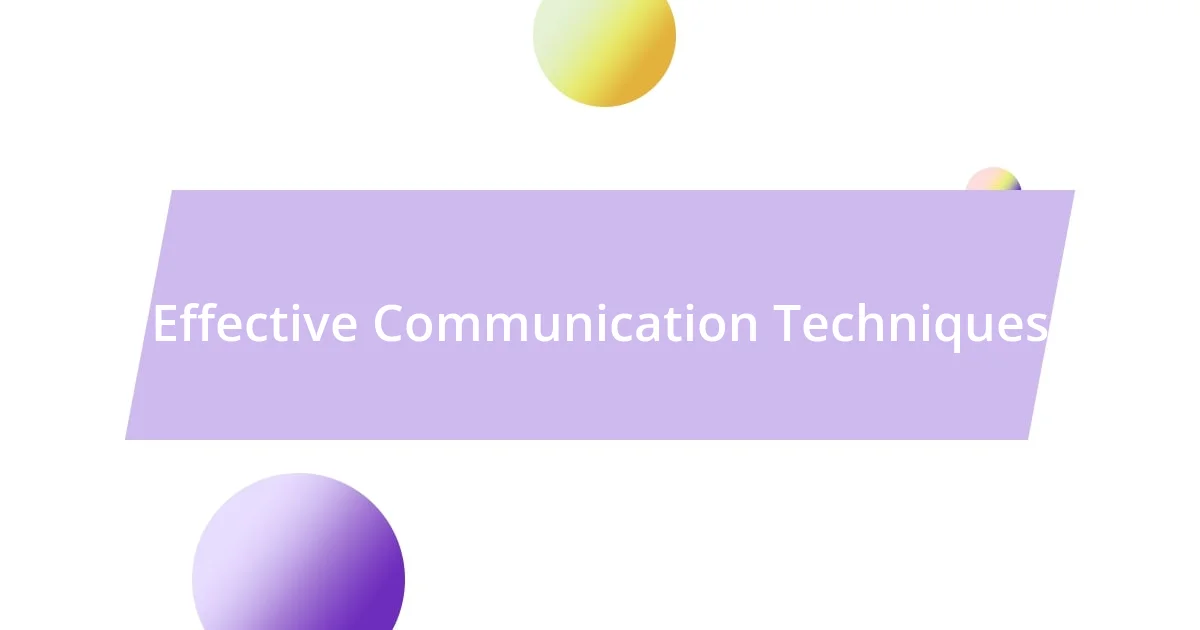Key takeaways:
- Understanding couples’ dynamics involves recognizing unique communication styles and emotional backgrounds, which significantly impact their interactions and connection.
- Creating a comfortable environment, including appropriate lighting and emotional safety, enhances openness and encourages healthy communication among couples.
- Effective communication techniques, such as active listening and using “I statements,” are crucial for resolving conflicts and fostering deeper emotional connections between partners.

Understanding Couple’s Dynamics
Understanding couple dynamics requires a nuanced approach, as every relationship operates on its own unique wavelengths. I remember when I first started directing couples; I was fascinated by how their interactions shifted depending on their mood and context. Have you ever noticed how a simple inside joke or shared memory changes the energy in a room? Those subtle cues are incredibly revealing.
In my experience, communication styles play a huge role in how couples relate to each other. For instance, I once directed a couple where one partner preferred direct confrontation, while the other avoided conflict altogether. It was challenging to navigate that, but it made me realize how crucial it is to understand these preferences to foster a comfortable environment. How do you think different communication styles can either bridge gaps or widen divides?
Moreover, emotional backgrounds can shape a couple’s dynamic in profound ways. I once worked with a couple where one partner had a history of emotional vulnerability, and the other grew up in a family that valued stoicism. This created an interesting tension during our sessions, pushing both to explore their feelings deeply. It begs the question: how much do our individual pasts influence our relationships? Acknowledging these backgrounds is essential in guiding couples toward a deeper understanding of themselves and each other.

Establishing a Comfortable Environment
Creating a comfortable environment is vital in helping couples feel at ease. I’ve found that setting the right atmosphere—be it through lighting, seating arrangements, or even background music—can significantly influence how open couples are with each other. For instance, I once dimmed the lights and played soft instrumental music during a session. The couple instantly relaxed, allowing for a more genuine conversation to unfold.
It’s not just about physical comfort; it’s also about emotional safety. During one session, I noticed a couple hesitating to share their thoughts. To help ease their tension, I shared a light-hearted story about a misunderstanding I had with my partner. This anecdote sparked laughter and opened the door for them to share their experiences. When you can relate on a human level, it’s astounding how barriers dissolve.
Lastly, consider the importance of space. I remember directing a couple in a small, cluttered room, and it felt overwhelming. When I moved our session to a more spacious environment that felt inviting, their body language shifted dramatically. They leaned into each other more and engaged openly, emphasizing that a comfortable setting can indeed change the dynamics significantly.
| Element | Impact on Comfort |
|---|---|
| Lighting | Creates inviting atmosphere, influences mood |
| Seating Arrangement | Encourages closeness or distance |
| Background Music | Helps ease tension, promotes relaxation |
| Space | Reduces feelings of confinement, enhances openness |

Effective Communication Techniques
I’ve learned that effective communication is the cornerstone of any relationship. When directing couples, I always emphasize the power of active listening. I once worked with a couple where one partner often felt unheard. By introducing simple techniques like reflecting back what each person said, I witnessed a remarkable transformation in their conversation. They began to feel truly seen and validated, which is crucial in developing trust.
To enhance communication, here are a few techniques I’ve found to be effective:
- Active Listening: Focus entirely on the speaker, acknowledging their feelings and thoughts.
- I Statements: Encourage couples to express their feelings with statements like “I feel…” to avoid blame.
- Open-Ended Questions: Promote deeper discussions by asking questions that cannot be answered with a simple “yes” or “no.”
- Summarizing: After a point is made, summarizing helps clarify understanding and shows that you are engaged in the conversation.
- Non-Verbal Cues: Pay attention to body language; it’s often just as telling as words.
I remember directing a couple who struggled to express their feelings. They often interrupted each other, which led to frustration. By guiding them to take turns speaking while the other listened intently, not only did their communication improve, but the emotional connection deepened. Observing those “aha” moments was incredibly rewarding, reminding me that effective communication can pave the way for a more fulfilling relationship.

Building Trust with Couples
Building trust with couples is essential for fostering a strong connection. I remember a session where one partner was visibly guarded, hesitant to share. After casually acknowledging the discomfort in the room and openly discussing trust, the atmosphere shifted. It’s fascinating how just uttering the word “trust” can invite vulnerability, sparking deeper conversations. How often do we think about the power of vulnerability in our own relationships?
Another critical aspect of trust involves consistency in my approach. I strive to create an environment free of judgment, ensuring couples know they can express themselves without reservation. For instance, during one session, I made a point of reinforcing that every emotion is valid. This openness allowed one partner to articulate feelings they previously held back, leading their partner to respond thoughtfully instead of defensively. Moments like this remind me how trust builds upon small, everyday interactions.
Finally, I find that a little humor can go a long way in building trust. In one instance, I shared a funny mishap from my own relationship, and the couple erupted in laughter. This shared moment of levity broke the ice and created a sense of camaraderie. It’s intriguing to think: How many walls can be washed away with a simple chuckle? Trust is an evolving journey, and every shared story can serve as a stepping stone toward greater intimacy.

Guiding Couples through Activities
Guiding couples through activities often means steering them into situations that promote collaboration and intimacy. Personally, I’ve facilitated trust-building exercises, like creating a joint vision board. I still remember the couple who started with hesitation but ended up filled with excitement as they envisioned their shared future. It was amazing to witness how visualizing goals together opened avenues for deeper discussions, fostering not just teamwork but genuine emotional connection.
During my sessions, I often emphasize playful activities like trust falls or partnered challenges. One time, I guided a couple through a cooking activity where they had to rely on each other’s skills and suggestions. At first, there was some bickering, but as they navigated the recipe, I noticed them laughing and working in rhythm. It struck me just how powerful shared tasks can be in rewriting a narrative—transforming frustration into fun and cooperation, which are central to a healthy relationship.
I find that including a bit of competition can spice things up too. I once organized a friendly game where couples had to answer fun facts about each other. The room was alive with laughter and playful banter, which made the intimate setting less daunting. I’ve often wondered: Can a little healthy rivalry bridge gaps and shift dynamics in a relationship? I believe it can, as it shows couples that working together can lead to not only growth but also enjoyment in each other’s company.

Managing Conflicts during Sessions
Managing conflicts during sessions can seem daunting, but I’ve discovered that creating a safe space for open dialogue makes a significant difference. I recall a particularly intense session where tensions escalated. I gently intervened, asking each partner to express their feelings one at a time, allowing them to truly listen to each other. In that moment of pause, it was like watching a kettle simmer down—emotions settled, and understanding began to flourish.
There are times when I’ve sensed an impasse, and a targeted technique can help navigate through it. In one session, I encouraged a couple to practice “active listening,” where they paraphrased what their partner said before responding. I still remember the shift in energy when one partner realized they were heard; it was as if a beam of light pierced through a cloudy day. Isn’t it interesting how simply being validated can transform a conflict into a productive conversation?
Ultimately, my approach is to recognize and normalize conflict as part of any relationship. I often share a personal story about a disagreement I had with a close friend and how it led to deeper understanding. By framing conflicts as opportunities for growth, I help couples shift their perspective. When we embrace the idea that disagreements can lead to insights, isn’t that where true intimacy begins to blossom?

Evaluating Progress and Feedback
Evaluating progress and providing feedback is crucial in guiding couples through their journey together. I remember a particular session where I asked a couple to reflect on their experiences after completing an exercise. To my surprise, their feedback was overwhelmingly positive—they felt more connected and understood their partner’s perspective better. This exchange not only validated their efforts but also reinforced my belief that open communication is the bedrock of progress.
As we evaluate progress, I find that incorporating structured feedback sessions can be incredibly beneficial. In one instance, I created a simple checklist for a couple to fill out, rating their comfort and connection after each activity. Reflecting on these ratings during our sessions revealed patterns that guided our focus. It’s fascinating how a few quick questions can unveil deeper insights into their relationship dynamics—don’t you agree that this kind of clarity is invaluable?
Ultimately, my goal is to ensure couples feel empowered to discuss their journey openly. I encourage them to share both positive experiences and areas where they feel stuck, framing it as a partnership in growth. Each time I facilitate these discussions, I’m reminded of the beauty in vulnerability—it’s in those moments of honesty that true breakthroughs occur. Isn’t it amazing how evaluating progress can not only chart a path forward but also strengthen the bond between partners?














